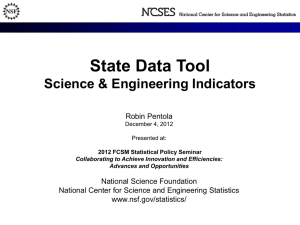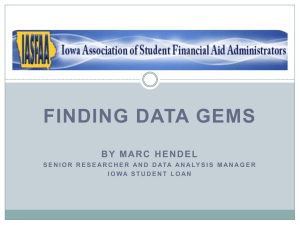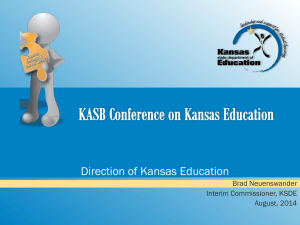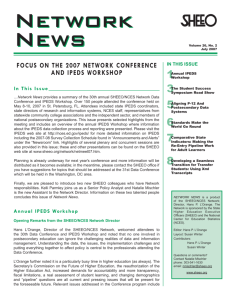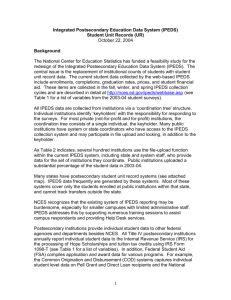Institutional Research: What*s It All About? Part II
advertisement
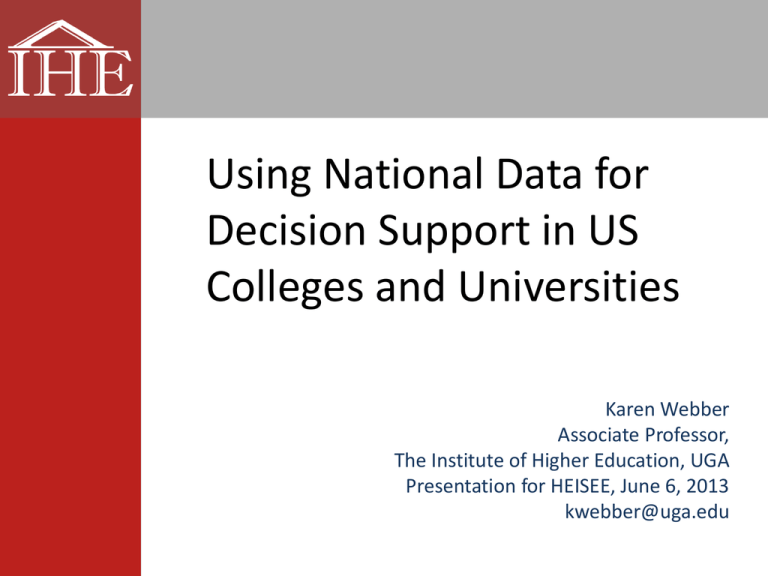
Using National Data for Decision Support in US Colleges and Universities Karen Webber Associate Professor, The Institute of Higher Education, UGA Presentation for HEISEE, June 6, 2013 kwebber@uga.edu • • • • Institutional Research Institutional Effectiveness Quality Assurance Planning and Research KWebber HEISEE 2013 Institutional Research A focus on: the collection, analysis, and reporting of information that leads to improved understanding, planning, and operating of institutions of higher education KWebber HEISEE 2013 Data Collection and Use of Data • Very helpful for institutional planning, quality assurance • Can be used for benchmarking • May start small, informal • As more institutions get involved, grows larger, may take on formal procedures • Critical to have good infrastructure/technology • Critical to have definitions to ensure consistency KWebber HEISEE 2013 Institutional or System Database(s) Student Data • Addresses, enrolment qualifying scores, course grades, etc HR Data • Address, phone, faculties group, etc Central data repository or Data Warehouse Finance Facilities KWebber HEISEE 2013 • Tuition & fees, • E&G expenditures, salary & benefits •# buildings, sq ft figures, equipment, Who Uses National/Regional Data and Why? • Many with Inquiring Minds: – – – – – Institutional Research/academic planning officials Educational researchers Graduate students Legislators Policy Analysts • Why? – – – – – Academic/administrative planning within an institution Assessment; evidence of meeting goals, strategic plans Scholarly inquiry Policy, budget planning Generalizable; reliable, good for policy considerations KWebber HEISEE 2013 Some data systems for higher education • Australia – Higher Education Statistics Collection http://www.innovation.gov.au/HigherEducation/HigherEducationStatistics/Pages/ OverviewOfHigherEducationStatisticsCollections.aspx – HERDC http://www.innovation.gov.au/Research/ResearchBlockGrants/Pages/HigherEduc ationResearchDataCollection.aspx • South Africa – CHE and HEMIS – http://www.che.ac.za/about/ • EUMIDA – http://datahub.io/dataset/eumida • UK – HESA – http://www.hesa.ac.uk/ – http://www.ukcisa.org.uk/about/statistics_he.php • Middle East, Latin America – beginning KWebber HEISEE 2013 Data Systems for Higher Education • EU – OECD Statistics and Data Lab – http://www.oecd.org/statistics/ • Eurostats – http://epp.eurostat.ec.europa.eu/portal/page/portal/education/introduction • The World Bank data – http://data.worldbank.org/data-catalog/ed-stats • World Higher Education Database Online – http://www.whed-online.com/about.aspx • Croatia – – Croatian Bureau of Statistics, IDIZ, IED, CEP, ? Institutions, others • US – IPEDS, NCES, NSF KWebber HEISEE 2013 U.S. Department of Education Mission – to ensure equal access to education and to promote educational excellence throughout the nation. Supplements and complements the efforts of states, local school systems and other instrumentalities of states, private sector, public and private nonprofit educational research institutions, community-based organizations, parents, and students to improve the quality of education. http://ed.gov KWebber HEISEE 2013 U.S. Department of Education • Establishes policies on federal financial aid (distributes and monitors those funds) • Collects data on America's schools and distributes research via reports and in some cases, datasets • Focuses national attention on key educational issues • Prohibits discrimination and ensures equal access to education KWebber HEISEE 2013 National Center for Education Statistics (NCES) NCES is the primary Federal agency responsible for the collection, analysis, and the reporting of data related to education in the United States KWebber HEISEE 2013 National Center for Education Statistics (NCES) On the web… • Monitoring Programs • Publications • Collecting Data http://nces.ed.gov KWebber HEISEE 2013 • Educational Level – Early childhood – Primary/secondary – Postsecondary • Type of Data – Cross-sectional – Longitudinal • Unit of Analysis – Individual Student or Faculty member – School (institution) KWebber HEISEE 2013 NCES Data Sets • IPEDS (Integrated Postsecondary Education Data System) • • • • • • • • Baccalaureate & Beyond (B&B) Beginning Postsecondary Students Longitudinal Study (BPS) Career/Technical Education Statistics (CTES) High School & Beyond (HS&B) National Longitudinal Study of 1972 (NLS) National Postsecondary Study of Financial Aid (NPSAS) National Study of Postsecondary Faculty (NSOPF) Postsecondary Education Transcript Collection (PETS) • • Interagency Expanded Measures Enrollment & Attainment (GEMEnA) Statewide Longitudinal Data Systems Grant Program (SLDS) • • Postsecondary Education Descriptive Analysis Rpts (PEDAR) Postsecondary Education Quick Information System (PEQIS) http://nces.ed.gov/surveys/SurveyGroups.asp?group=2 Data Access • Both NCES and NSF have some publicly-available data • And some restricted access files KWebber HEISEE 2013 Data Tools from NCES • Executive Peer Tool (ExPT) • Peer Analysis System (PAS) • Powerstats and Data Analysis System (DAS) KWebber HEISEE 2013 Short Demonstration KWebber HEISEE 2013 KWebber HEISEE 2013 KWebber HEISEE 2013 National Science Foundation – Nat Center for Science & Engineering Statistics (NCSES) • The responsibilities of NCSES have been broadened from those of the former Division of Science Resources Statistics. Data collections related to U.S. competitiveness and STEM education are part of these new responsibilities. NCSES is responsible for statistical data on the following: – – – – • • • • • Research and development The science and engineering workforce U.S. competitiveness in science, engineering, technology, and R&D The condition and progress of STEM education in the United States Core Activities. As one of 13 federal statistical agencies, NCSES designs, supports, and directs periodic national surveys and performs a variety of other data collections and research. The America COMPETES Reauthorization Act codifies the role of NCSES in supporting research using the data that it collects and its role in research methodologies related to its work. The legislation specifies the responsibilities of NCSES in supporting the education and training of researchers who use large-scale data sets, such as the ones NCSES now collects. The following activities form the core of NCSES work: The collection, acquisition, analysis, reporting, and dissemination of statistical data related to the United States and other nations Support of research that uses NCSES data Methodological research in areas related to its work Education and training of researchers in the use of large-scale nationally representative data sets http://nsf.gov/statistics/about.cfm KWebber HEISEE 2013 NSF - NCSES • Each year produces about 30 publications, which can be roughly divided into the following categories: • InfoBriefs highlighting results from recent surveys and analyses; • Detailed Statistical Tables (DSTs) containing extensive tabulated data from a particular survey; • Periodic "overview" reports, such as Science and Engineering Indicators and Women, Minorities, and Persons With Disabilities in Science and Engineering; and • Special reports, such as Interstate Migration Patterns of Recent Recipients of Bachelor's and Master's Degrees in Science and Engineering and Gender Differences in the Careers of Academic Scientists and Engineers. KWebber HEISEE 2013 NSF Data Tools WebCASPAR and SESTAT • provides easy access to a large body of statistical data resources for science and engineering (S&E) at U.S. academic institutions. • emphasizes S&E, but its data resources also provide some information on nonS&E fields and higher education in general. • https://webcaspar.nsf.gov/ • http://www.nsf.gov/statistics/sestat/ KWebber HEISEE 2013 These Data Are Useful • Intra- and inter-institutional data comparisons • Monitor institutional progress, help with decisions • Help national leaders monitor US higher education broadly – Reports and other information to the public KWebber HEISEE 2013 Data Used on Campus • Ad hoc or regular, on-going reports to senior administrators (e.g., deans, rectors, vice rectors) • Institution Fact Book KWebber HEISEE 2013 Also used for analytic studies • Almost endless number of good research questions can be generated • Examples: – Student access to higher education, graduate school • Student demographics, location, type institution – Effects of financial aid on student completion – Where/what do degree recipients go/do after graduation? – What is relationship between financial allocations and institutional outcomes KWebber HEISEE 2013 Example Research Studies In US- a current focus on student financial aid Study on graduate student financial aid debt (Belasco, Trivette, & Webber, 2013) • NPSAS data 2000 and 2008 • About 49% all graduate students borrowed for school in 2008; increased to 59% in 2008 • Mean debt $42,000 in 2008 • Higher for doctoral and professional students, but more master’s • More debt incurred by Black and Hispanic, less for Asian than white students KWebber HEISEE 2013 Also a focus on degree completion Study on benefits of the earned doctorate (Webber et al, 2013) Using NSF’s Survey of Doctorate Recipients: • What individual economic benefits accrue for doctoral degree recipients from the time of doctorate graduation (1998-99) to the present time (2008)? • Are there differences in the economic benefits resulting from debt assumed and sources of financial support during degree enrollment? • What effect does time to degree completion have on the economic benefits obtained by doctoral degree recipients? KWebber HEISEE 2013 KW study on benefits of the earned doctorate Average Annual Salary of Doctorate Recipients by Job Sector $130,464 2008 $112,799 $104,336 $117,001 2006 $99,309 $90,175 Business & Industry $107,503 2003 $90,055 $80,893 Government Education $99,846 2001 $81,560 $71,738 $86,999 1999 $72,189 $62,051 $0 $20,000 $40,000 $60,000 $80,000 Source: Survey of Doctorate Recipients, National Science Foundation $100,000 $120,000 $140,000 KWebber HEISEE 2013 Interest in faculty work and faculty productivity Study on Postsecondary Faculty (Webber, 2012) Using 2004 National Study of Postsecondary Faculty: • What factors contribute to a faculty member’s research productivity • Are there differences in productivity for USvs. Foreign-Born faculty/academic staff KWebber HEISEE 2013 Results from NSOPF study Recent Scholarly Works by US- V. Foreign-Born Status Born in US N=2990* Mean SD Foreign-Born N=1190 Mean SD p Refereed articles 3.81 4.846 5.56 5.862 ** Non-refereed articles 1.40 2.885 1.86 3.840 ** Book revw, chptrs, creative wrks 1.23 2.180 1.20 2.063 .61 1.525 .66 1.496 ** Presentations 5.84 6.792 7.22 7.177 ** Exhibitions, performances 1.23 6.453 .36 3.067 ** .15 .683 .24 .830 ** 7.07 9.491 9.29 9.355 ** Books, textbooks Patents Total Recent Written Works ** p <.01 * all Ns are weighted and rounded KWebber HEISEE 2013 Results from NSOPF:04 Time Allocations and Salary by US- V. Foreign-Born Status Born in US N=2990* Mean Foreign-Born N=1190 SD Mean SD p % Time on Research 32.83 22.205 39.43 21.926 ** % Time on UG Instruction 30.96 26.839 24.47 23.163 ** % Time on Graduate Instruct 22.37 19.834 23.56 17.183 % Time Other Activities 13.85 12.880 12.55 12.437 ** 227.76 269.761 184.70 206.012 ** Base salary $78,277 $34,453 $79,936 $33,677 Total annual income $95,726 $46,423 $94,540 $43,154 Student Credit Hours Generated Annual Salary KWebber HEISEE 2013 Growing Discussions About Postdoctoral Researchers KWebber HEISEE 2013 Study on postdoctoral researchers (Yang & Webber, 2013) • Does the choice to take a postdoctorate research experience affect career path? • Does taking a postodoctorate research experience affect productivity or salary a decade later? KWebber HEISEE 2013 Results on postdoc study • Taking one or more postdoc appointments significantly increased likelihood of going to education sector and earning a tenure-track faculty appointment • Take one postdoc increases productivity, but two or more does not add more • Taking postdoc does not affect salary 10 years later KWebber HEISEE 2013 Questions, Discussion • Questions on IPEDS? • What are the most pressing questions that you have that would be better answered with data similar to IPEDS? • What are the obstacles to interinstitution data collection in Croatia? KWebber HEISEE 2013 Critical Elements • Good data infrastructure • Data definitions to ensure consistency KWebber HEISEE 2013 This may be of interest Principles and Practices for a Federal Statistical Agency Constance F. Citro and Miron L. Straf, Editors Committee on National Statistics; Division on Behavioral and Social Sciences and Education; National Research Council , 2013. KWebber HEISEE 2013 Principles for a federal statistical agency (Citro & Straf, Eds., 2013) • • • • Relevance to policy issues Credibility among data users Trust among data providers Independence from political and other undue external influence KWebber HEISEE 2013
